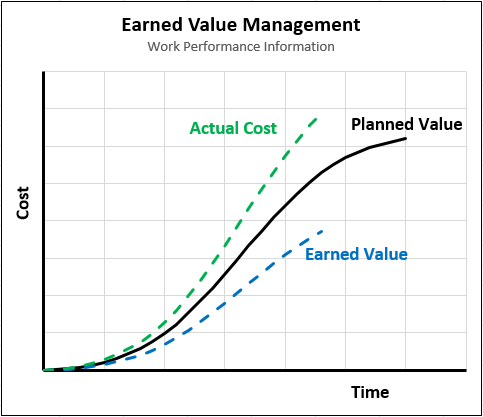If you’re new to budgeting a project or understanding project cost management, you might be wondering what all these acronyms stand for. What’s the difference between Earned Value (EV) and Actual Value (AV)? What is a Cost Performance Index (CPI), and how is it calculated? What is a Schedule Performance Index (SPI), and how is it calculated? What is variance reporting? What is variance analysis? What does it mean to have a positive or negative variance?
An over budget or past due project can have costly consequences for a business. Clients will be unhappy if a project is late or needs additional resources, employees may become overworked trying to scramble at the last minute, and, depending how far off the rails a project gets, you could lose money.
That’s why planning and maintaining project budgets and schedules is so important when managing a project. Once a plan is in place, it’s important that everyone involved stick to it as best they can.
There are a number of different calculations you can make in order to tell whether or not a project is on schedule according to cost and amount of time left. This needs to be done throughout a project so that teams (and accountants!) understand how far ahead or behind a project is falling. And that’s what we’ll discuss in this post. We’ll define common project cost management terms, explain how to calculate cost performance index, and provide formulas for calculating variances in cost and schedule.
- What is a Cost Performance Index (CPI)?
- The Cost Performance Index Formula
- Earned Value Formula (EV)
- Actual Cost (AC)
- What is a Schedule Performance Index (SPI)?
- The Schedule Performance Variance Formula
- Negative Variance vs. Positive Variance
- How to Calculate Cost Variance (CV)
-
How to Calculate Schedule Variance (SV)
What is a Cost Performance Index (CPI)?
A Cost Performance Index is used to better understand efficiency of resources for any given project. It measures cost efficiency with a CPI ratio that indicates whether a project is going well according to financial effectiveness.
The Cost Performance Index Formula
The formula for calculating Cost Performance Index requires two values: Earned Value divided by Actual Cost. The formula is as follows:
Cost Performance Index (CPI) = Earned Value (EV) / Actual Cost (AC)
Once calculated, this ratio gives insight into a project's current financial state at any given time of the project. It helps teams and project managers understand if a project is performing according to budget, if it is over budget, or if it is under budget.
- A CPI of 1 means the project is currently performing as budgeted.
- A CPI of less than 1 means the project is currently over budget.
-
A CPI of more than 1 means the project is currently under budget.
Let’s say your current EV for a given project is $20,000, and your AC is $18,000. If you divide your EV by AC ($20,000/$18,000 = 1.11), you get a CPI of 1.11, which is good news. Your CPI is above 1, which means your project is currently under budget.
In another example, let’s say your current EV is $55,000, and your AC is $58,000. If you divide your EV by AC ($55,000/$58,000 = 0.95), you get a CPI of 0.95. This is bad news for any project, indicating that you are over budget. The closer you get to the end of a project with a CPI of below 1, the less time you have to course correct and make adjustments before the project ends up costing more than you planned for.
In order to calculate CPI, Earned Value and Actual Value are needed—but how do we get those numbers to begin with?
Earned Value Formula (EV)
The Earned Value in project management captures the level of work currently completed against what was originally planned. Earned value management formulas are calculated by taking the percent of work performed (so far) and multiplying that percentage by the total project budget, BAC, which stands for Budget at Completion.
Earned Value (EV) = % of work completed x BAC
For example, if your project is 50% complete in terms of work performed, and your project budget is $50,000, your EV would equal $25,000. Calculated by:
50% (50/100) x $50,000 = $25,000 (EV)
For another example, if your project is 25% complete in terms of work performed, and your project budget is $110,000, your EV would equal $27,500. Calculated by:
25% (25/100) x $110,000 = $27,500 (EV)
An EV provides the most insights when used alongside other calculations. You can use an EV to calculate Cost Performance Index (CPI), Schedule Performance Variance (SPI), Cost Variance (CV), and Schedule Variance (SV).
Actual Cost (AC)
The Actual Cost (AC) is, quite literally, the actual amount you've spent on work at any given time. This doesn’t require any sort of formula to calculate; it’s simply the actual amount you’ve spent completing the work so far.
AC is used to calculate Cost Performance Index (CPI) as well as Cost Variance (CV).
What is a Schedule Performance Index (SPI)?
A Schedule Performance Index (SPI) is very similar to CPI, but instead of calculating cost efficiency, like with CPI, the SPI calculates schedule efficiency. It measures how efficiently the team is completing work based on the Earned Value (EV) and Planned Value (PV). Planned Value is calculated by the planned % complete x BAC.
Schedule Performance Variance (SPI) = Earned Value (EV) / Planned Value (PV)
- An SPI of 1 means the project is currently on schedule.
- An SPI of less than 1 means the project is currently behind schedule.
-
An SPI of more than 1 means the project is currently ahead of schedule.
Negative Variance vs. Positive Variance
There are two types of variances you need to calculate in project cost management: Cost Variance (CV) and Schedule Variance (SV).
Cost Variance represents the difference in cost between your planned budget and actual spend at any moment. With this calculation, you are able to see if you are over or under budget at any given time.
Schedule Variance represents the difference in time between your planned schedule and the actual work completed so far. With this calculation, you are able to see if you are ahead of or behind schedule whenever you need to.
Calculating a negative variance means you are behind, which means over budget for CV or behind in work completed for SV. Calculating a positive variance means you are ahead, which means under budget for CV or ahead in the amount of work completed for SV.
How to Calculate Cost Variance (CV)
The Cost Variance (CV) calculation lets you know how far ahead or behind you are budget-wise for a project at any given time. It’s calculated using Earned Value (EV) and subtracting Actual Cost (AC).
Cost Variance (CV) = Earned Value (EV) - Actual Cost (AC)
A negative cost variance is bad news. It means your project is currently over budget, and you need to course correct as soon as possible. On the other hand, if your cost variance is positive, it means you are doing well and are under budget for the project so far.
- A CV of 0 means the project budget is currently exactly as planned.
- A negative CV means the project is currently over budget.
-
A positive CV means the project is currently under budget.
How to Calculate Schedule Variance (SV)
The Schedule Variance (SV) calculation lets you know how far ahead or behind you are in work planned for a project at any given time. The Schedule Variance formula is calculated using Earned Value (EV) and subtracting Planned Value (PV).
Schedule Variance (CV) = Earned Value (EV) - Planned Value (PV)
A negative schedule variance is a bad sign. It means the project is currently behind schedule and may not be completed in time if changes aren’t made. It’s a good sign if your schedule variance is positive, meaning you are currently ahead of schedule for the work that needs to be done for the project to be completed as planned.
- An SV of 0 means the project budget is currently exactly on schedule.
- A negative SV means the project is currently behind schedule.
-
A positive SV means the project is currently ahead of schedule.
More from Blue Summit Supplies
💡 Speaking of keeping budgets on track, learn how to find affordable office supplies and establish an effective office supply budget.
💡 Do all of these calculations have you scratching your head? An executive coach could be just what you need to keep your business afloat. Learn more about executive coaching and how to find the best one for you.
Follow our office blog dedicated to helping businesses thrive. You’ll find the latest industry trends, office strategies, business tools, and more. If you have any questions or want to talk to someone about office supplies, reach out to our team at any time.
 For more informative articles about office supplies, subscribe to our email newsletter!
For more informative articles about office supplies, subscribe to our email newsletter!
Never fear, you won't begin receiving daily sales emails that belong in a spam folder. Instead, we promise a fun weekly roundup of our latest blog posts and great finds from across the web. And if you lose interest, it's always easy to unsubscribe with a single click.












1 comment
Jeff Risner
Thanks. This was a VERY helpful explanation of some key calculations in prep for taking the PMP exam.
I do want to note a couple of minor mistakes in wording:
In your section that reads, “An EV provides the most insights when used alongside other calculations. You can use an EV to calculate Cost Performance Index (CPI), Schedule Performance Variance (SPI), Cost Variance (CV), and Schedule Variance (SV).”, your reference to “Schedule Performance Variance (SPI)” should be “Schedule Performance Index (SPI).”
In your calculation “Schedule Variance (CV) = Earned Value (EV) – Planned Value (PV)”, Schedule Variance should be (SV), not (CV).